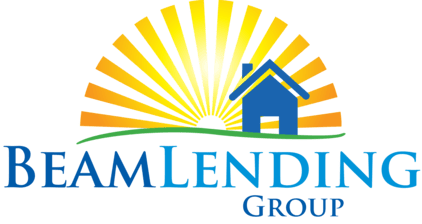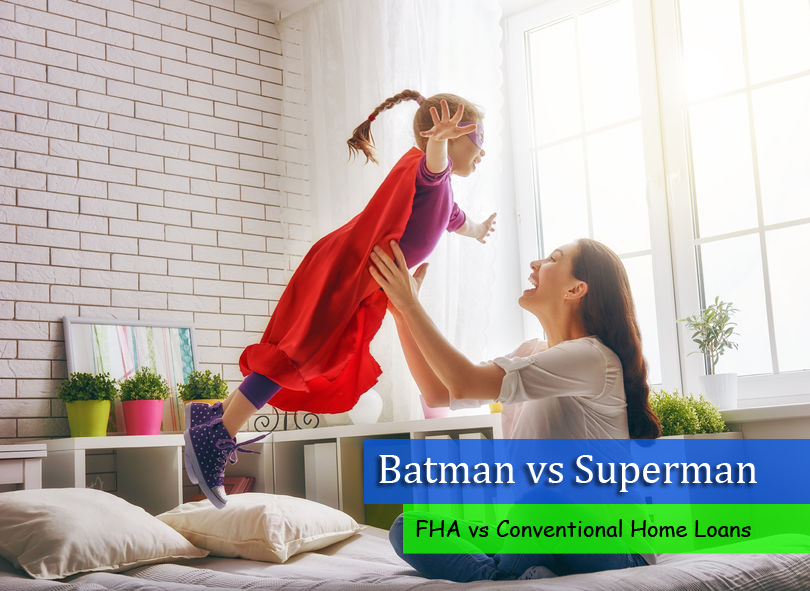There’s an interesting debate that pops up on the internet every now and then as to who is the better super hero – Batman vs Superman. Some believe that Batman’s keen intellect, scientific know-how and vast assortment of weaponry give him the edge. On the other hand you can’t teach speed, Superman’s super speed would overwhelm Batman’s human speed in a blink of an eye. One person maintained that some evil plots are better solved by Batman, while other dastardly deeds lend themselves more to the skills of Superman.
Which leads us to our question for the day: “Which is better, an FHA loan or a Conventional loan?”
Well, like our super heroes, they both have their strengths – and weaknesses. Let’s take a closer look.
FHA – FHA-backed loans are popular for several reasons, including:
- FHA requires only 3.5% down payment
- FHA allows refinancing without an appraisal
- FHA mortgage rates are usually lower
- Credit scores can be lower than those for a conventional loan
Many people make the mistake of assuming that FHA loans come from the Federal Housing Administration (FHA). FHA does not provide the money for loans but rather insures the loans given by approved lenders. Should a borrower ever default on the loan the FHA stands ready to repay the lender’s loss. These default claims are paid from the Mutual Mortgage Insurance (MMI) fund. This fund is financed by two types of mortgage insurance premiums which are paid by the borrowers. The two types of premiums are:
- The FHA Upfront Mortgage Insurance Premium (UFMIP)
- The FHA annual Mortgage Insurance Premium (MIP)
The FHA’s current upfront mortgage insurance premium (UFMIP) is 1.75 percent of the loan. Let’s suppose someone uses an FHA-backed mortgage to buy a $200,000 home. The Upfront MIP would be 1.75 percent of $200,000, or $3,500. The Upfront MIP is not paid in cash but is added to the loan balance. The actual borrowed amount on a $200,000 loan would be $203,500.
In addition to the UFMIP the buyer in this example must also pay $225 per month for the Mortgage Insurance Premium (MIP). If the borrower in this example keeps the home for 10 years before selling (or refinancing) the cost would add up to about $30,000 in mortgage insurance fees. Pretty pricey. Conventional – This type of loan is not insured by a government agency. The borrower must come up with a down payment of at least 5% of the cost of the home. But no 1.75% upfront fee is added to the loan. And the monthly mortgage insurance premium on a conventional mortgage can be less than half of FHA’s insurance. That adds up to significant savings over the life of a 30 year loan.
Another advantage of a conventional loan is that the mortgage insurance payment drops off once the home owner has paid for at least 20% of the home. The lender is required by law to terminate the mortgage insurance when the loan balance has reached 78 percent of the original value of the home. When that time comes, the homeowner must be current on the loan.
So why would anyone want to get an FHA loan? For those with a lower credit score or those unable to come up with a 5% down payment, the FHA loan can open the door to home-ownership. But keep in mind the additional cost in the long run. You may want to consider holding off so you can save up and put down 5%. That would cost you more upfront but bring about significant savings in the long run.
So as we put these two loans side by side which is the better loan? I think the guy on the internet had the right idea. It depends on the situation. Sometimes you need a Batman. And other times Superman is the best super hero for the job.
Action Item – Shoot me a message, ccarver@beamlending, for a quick loan quote or for any loan questions.
Copyright: choreograph / 123RF Stock Photo

